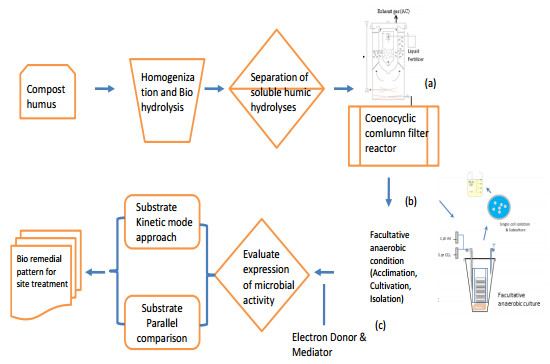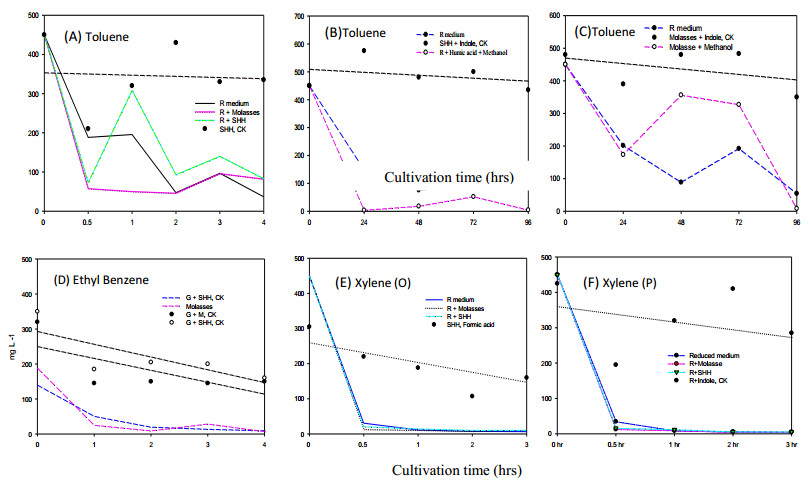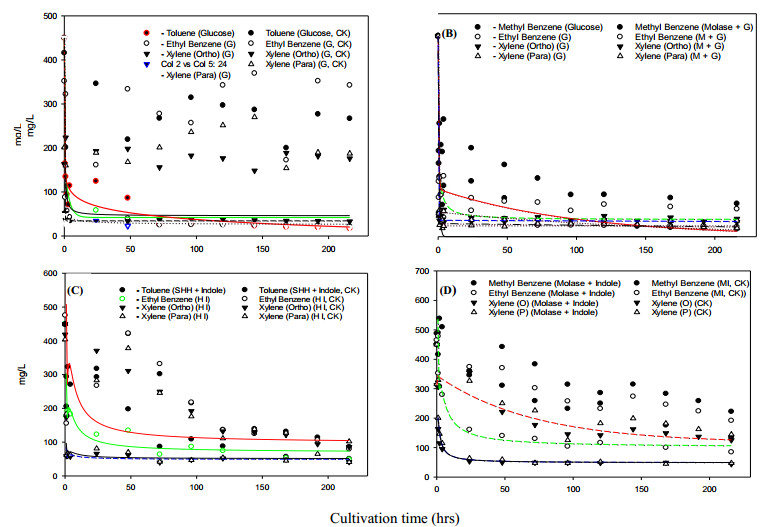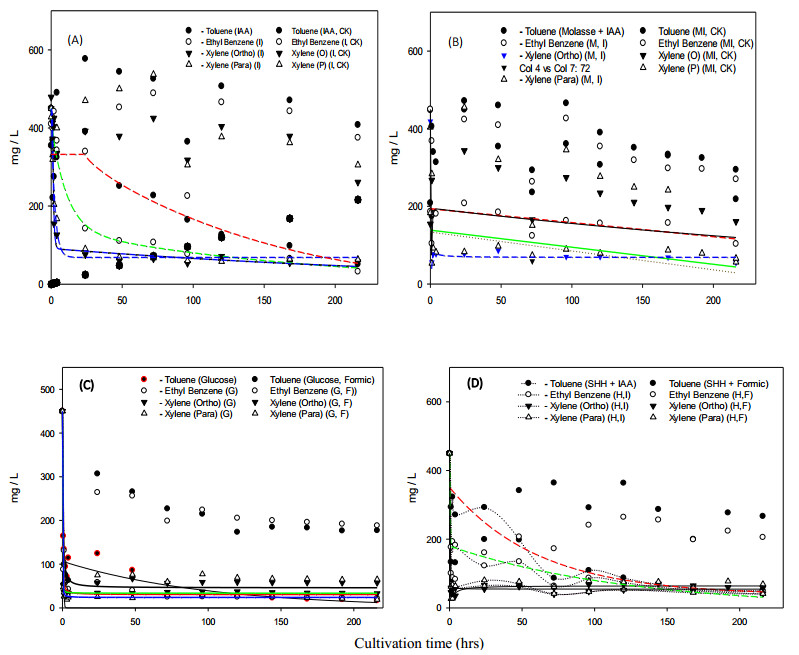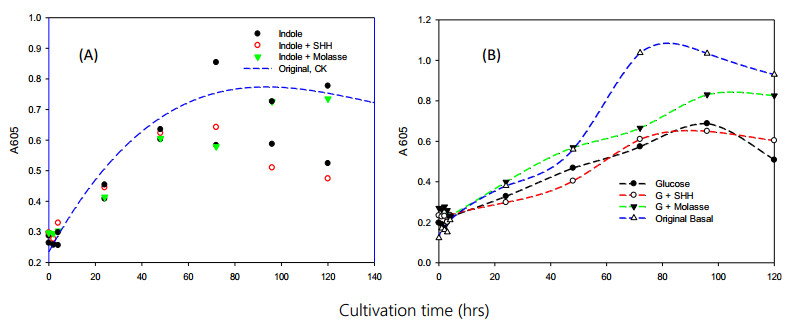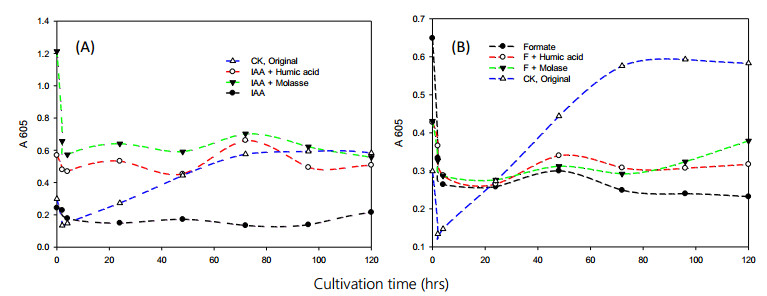1.
Introduction
Benzene, toluene, ethylbenzene and xylenes (BTEX) are widely distributed in paint, gasoline additives, chemical foaming, etc., as important blenders for industrial products and bonding agents for architectural materials. As small hydrophobic molecules, they readily diffuse into the lipid layer, which causes chronic deterioration of the respiration system through lipid adhesion and invasion and carcinogenic effects, which cause public health concerns [1]. The recalcitrance toward biological degradation was due to its aromatic ring being prone to damage the cell membrane, bacteria acclimated to secreting surfactant and enzymes, leading to hydrolysis or transformation via hydroxylation, ketonization and carboxylation in the metabolic route, and completion of final ring cleavage via a microbial community involving various respiratory types of microbes [2,3], which have complementary properties via aerobic (+O) or anaerobic (+H) metabolism acclimated to accomplish biological catalytic roles. Nevertheless, the latter has the benefit of saving energy and easily reproducing stable operation in the time of acclimated consortium. In addition to being catalyzed by redox enzymes, aerobic bacteria are prone to secrete extracellular components mediated as surfactants to enhance extraction and exert hydrolytic effects for total petroleum hydrocarbon (TPH) remediation. Parallel results also indicate that over 50% of 3% BTEX could be degraded simultaneously while hydrolyzing hydrocarbons. The integrated activity is stimulated by feeding 1 g/L glucose or 0.5 g/L yeast extract reported as an enrichment carbon source required for Bacillus spp. [4,5], and lithotrophic bacteria from soil could utilize TPH as the sole carbon source [6,7,8]. Bacillus spp. could be stimulated by cometabolism to stimulate redox enzymes. Additionally, the anaerobic metabolic route proceeded by grafting with long chain acids (for example fumarate into 4-methylbenzylsuccinic acid) was revealed to be the intermediate step for the exchange moiety in the electron-dense position [9,10,11,12]. Thus, the transformation step may be slow and hindered despite the fast redox reaction. Thus, the fermentative carbon source of melanoids, molasses, was profoundly enriched in both redox and primary carbon sources for TPH remediation based on their complex properties [13]. Thus, different origins of fermentable melanoids, such as heat and catalytic hydrolysis, have been used as conditioners [14] and further for experimental trials [15,16]. These compounds are worthy of study for their proliferative redox and hydrolysis potential for mediating PAH bioremediation [17,18,19].
The significance of the intermediate step for anaerobic fermentation [20,21] by modulating molecules–succinyl coA or hydroxylbenzene was indicated as a secondary metabolite that needed stepwise reform of the functional group to trigger bond cleavage. Proliferate aerobics could exert "mono-oxygenase" activity with splitting of water, protonization and formation of ester moieties as phthalate derivatives in the intermediate step during transformation. Previous studies indicated that aromatic mediators could provide suitable chemical forms for alkyl grafting to proceed with reactions [22]. Cometabolites such as methane [23], methanol [24], and organic acids [19] might quickly disrupt bonds hand provide bountiful reducing power for redox reactions, while aromatic derivatives [17] could enlarge their metabolic pool and mediate multiple remediation routes. The significance of implementing aromatic-containing carbon was of interest in possible future development for organic waste recycling and reuse in remediation and restoration.
Yoshikawa et al. 2017 indicated that the conversion of hydroxyl to carbonyl groups is the key pathway for BTEX transformation for further bond cleavage. Presently, we extend our intention to explore biring compounds as mediators for the interaction of metabolism and the switch electron stream to BTEX, especially pertaining to biological waste biomass (e.g., animal feces) or microbe matter (e.g., mushroom waste) for metabolic use [18,19].
In the development of an active consortium that proliferates from soluble humus hydrolysates (SHH) and melanoids, we constructed a facultative anaerobic column system for the acclimation of indigenous consortia from compost communities. Additionally, the bioremedial activity was assessed by analyzing the BTEX concentration until the removal efficiency rose steadily over 85% under daily feed batch operation. After operation for 6 months, isolates of bacteria from acclimated consortia were purified from the sludge under facultative anaerobic conditions and 16S DNA sequencing analysis. NCBI BLAST results showed nearly 100% identical species, and most were related to the genus Bacillus spp. In attempting to judge the physiological role directed by melanoid carbon under a facultative anaerobic state, cometabolic effects were evaluated by melanoid carbon sources, and bicyclic compounds were assessed singly or combined in fermentation. The significance of modulating molecules–as formulated electron donors and mediators (EDMs)–via different grafting properties was thus evaluated. The status of hydrolytic or redox enzymatic targeting for substrate and degradation in the literature is compared in Table 1.
2.
Materials and methods
2.1. Acclimation, isolation, and species identification of enriched TEX bioremediation consortia from a coenocyclic column reactor
Polyvinyl alcohol (PVA) porous medium was installed (up to 20% of solution volume) in a 10-L concentric column reactor (Figure 1a) in 3 parallel installations, with a bottom distributed perforating tube for intermittent aerated mixing. The primary mediator soluble humus hydrolysate (SHH) was released from kitchen waste compost (provided by Formosa Corp.) with mixed aromatics containing nutrients in a 1:1 ratio (v/v). The formulation with the final aromatics contained 400 mg/L toluene, ethylbenzene and xylene. Additionally, phenol (PTEX) was added to each substituted benzene for a common intermediate [19,33], and 1 g/L black sugarcane substituent (provided by Formosa Corp.) for daily feeding with a 10-day HRT rate. Phenol was used as a substitute for benzene due to the prohibition of its use over the health risk level. Since the hydroxyl group of phenol was widely used in cometabolic research [33,34] and proved to be an intermediate reactant in aromatic transformation [35], the addition of phenol to the substrate proceeded thereafter. The substrate was fed into the reactor by even distribution at 6-hour intervals 3 times a day to minimize toxic effects. Acclimation proceeded over half a year to stably produce active consortia. Facultative anaerobic conditions were controlled by limited air dissolution by periodic intermittent mixing with filtered air or circulation gas injected by purging for only 3 minutes with a 1/2 hp compressor at a working pressure of 0.4–0.8 kg/M3. After the effluent sample was verified to have a TEX reduction rate over 70% by gas chromatography, the active microbe stage was examined. Sludge consortia were serially diluted and cultured in original reducing medium (R medium) with limited nutrients, minerals, and Fe++/sulfide reducing power. R medium per liter contained 5 mg of boric acid, 0.3 g of magnesium sulfate, 0.5 mg of potassium iodide, 1 g of ammonium sulfate, 5 mg of ferrous sulfate, 0.3 g of sodium sulfide, 0.3 g of dipotassium hydrogen phosphate, 0.5 g of calcium sulfate, 1 mg of zinc sulfate, 0.5 g of brown sugar, 0.5 ml of premixed marine peptone (amino acid melanoid) and 0.25 g of vitamin B [24] per liter of deionized (DI) water. The medium was sterilized under steam pressure at 1.2 kg/CM2 for 20 minutes before adding PTEX carbon and collecting samples at time intervals for analyzing the TEX concentration [11]. Sterilized 10 mM phosphate buffer (pH 7.2) and 0.1% Triton X 100 buffer were prepared for serial dilution (106–108) for single colony isolation to achieve homogeneity under microaerophilic conditions [36,37]. Ten purified isolates were further subjected to 80 mL facultative anaerobic cultivation in 250 mL stainless steel (SUS # 304)-capped serum bottles to avoid air exchange. Two 3-mm tubes with edge neb clamps were assessed by press sealing with butyl rubber. One silicon tube was extended into the medium for ease of sampling with a syringe [38]. Serum bottles were sterilized as usual, and the vitamin and PTEX solution was sterilized by a 0.4 µm filter membrane and amended before inoculation. All experiments were performed in a constant rotary shaker with mixing at 100 rpm (Figure 1).
Over 15 purified isolates after at least 20 subcultures and a single colony were isolated repeatedly, and these highly homogenous colonies were examined under a microscope (>600 X) to ensure their homogeneity. Selected isolated plates were analyzed to reveal their proteinase activity, and 16 S DNA gene sequence comparisons were adopted for species identification. Chromosomal DNA primers were synthesized and used in PCR amplification (Bio-Rad 1000 PCR machine, USA) of bacterial genomic DNA (approximately 200 bp). The reaction proceeded in a 25 μL reaction tube using a PCR mix kit according to the procedure for customer service (Protech Technology Enterprise Co., Ltd., Taiwan). Eubacterial primers R16F2n (5'-GAAACGACTGCTAAGACTGG -3') (149-168) and R16R2 (5'-TGACGGGCGGTGTGTACAAACCCCG-3') (1373-1397) were used for the reaction. PCR was performed with the initial denaturation step at 95 ℃ for 30 s, annealing at 52 ℃ for 30 s, extension at 72 ℃ for 60 s, and final extension at 72 ℃ for 5 min. The PCR products were further purified by the kit from the Protech Corp, product then sequenced and subjected to BLAST search in the Gene Bank database (NCBI). The results showed the nearest identity specified at the species level, with 100% positivity. Proteinase activity was assayed by ninhydrin colorization with 2% collagen (50 mM pH 7.0 phosphate buffer) as the substrate. Activity was shown when added protein substrate and 0.5 mL 1% ninhydrin solution (in 50 mM, pH 7.0 phosphate buffer), 1.2 mL 50% glycerol (0.2 mL 50 mM, pH 7.0 buffer solution). The reacted solution was placed in hot water (>70 ℃) for heating for 12 minutes, and A570 was measured for evaluation of the amino acid produced. The reaction solute was simultaneously mixed under 120 rpm shaking and reacted for 2 hours, and 200 µL supernatant was collected at 4 ℃ after centrifugation at 13,000 rpm. The reacted solution visibly turned pink. The standard curve was calibrated by free amino acid (AA) with L-leucine as the end product, and standard solutions of 0, 80,160,240,360 and 400 µg/mL AA were prepared and analyzed as described above. One unit of enzyme activity was defined as 1 μmol/L leucine produced per minute [40]. Protein concentration was determined by a Bio-Rad Protein Assay Kit in 5 minutes. A595 was measured for calibration in a 0–20 μg/mL bovine serum albumin (BSA) linear regression curve to calibrate the concentration. Testing was performed with no cell, enzyme, or substrate as a control.
Electron donors, mediators and facultative anaerobic fermentation. Formic acid and methanol were analyzed as carbon sources. Primary mediators such as SHH were provided from cows by hydrolysis. After composting, acid catalytic (AC) oxidation was performed with 10–30% (w/w) sulfuric catalysts and microelements incorporated with ferrous, magnesium, manganese, molybdenum, and titanium ions (sulfate form, 2–6%) originated in Huang 2019, China Patent CN 106495884A. After steaming and autoclaving at 120 ℃ and 1.2 kg/CM hydrolysate solids were screened by 12, 50 wire mesh and 500 nm PBT pore membranes. Finally, through the finest ultrafiltration (UF) < 5 nm hollow fibers (Spectra / PorMicroFloat-A-Lyzer, Taiwan), a 10 kDa molecule was collected for fermentation. Another primary mediator was molasses, with macroaromatics and carbohydrates. The secondary mediator was physiologically active plant compounds, such as indole and indole acetic acid, formulated for evaluation [41]. Single or double combined additions were tested during the trial and run, and blank series were compared as an uninoculated control - CK; inhibiter formic acid was compared as a control.
Experimental protocol and activity evaluation for TEX bioremediation. Eighty milliliters of original reducing medium had various limited carbon electron donors for maintained vegetative growth. Other extra amended electron donors for analysis included glucose, methanol and formic acid. The primary mediator SHH was molasses. Secondary mediators, including indole and 3-indole triacetic acid, were surveyed for auxiliary mediation effects. Either one with 20 µM chemical amendment with SHH and molasses was followed by stock solution and dosed with A520 0.6, 1 ml added, inoculum suspension supplemented with A605≒ 1, with a 1% volume ratio. Incubation was set at 26 ℃ under 100 rpm rotary shaking conditions. Sampling at interval times included initial, 2 hours, 4 hours, 1 day, 2 days, 3 days, 4 days, 5 days, 7 days, and 9 days to analyze the volatile components in 3 mL of fermented solution [18]. Data were acquired by concentration pretreated by the VOC purge and trap apparatus (OI-Analytical, 4560, sample concentrator). Individual peak concentrations were analyzed by a gas chromatograph/flame ion detector (Agilent Technology 6850 net GC) [42,43]. The component concentration was calculated according to parallel standard solutions analyzed to build a linear calibration curve and kinetically evaluate the TEX concentration. Degradation efficiency was revealed by subtracting the formulation from the data of the control series. Experimental accessary equipment included microscales, constant-temperature shaker incubators, lamina flow, autoclaves (Tomin, 20 L) and spectrophotometers for cultivation use (Hitachi, model 2000).
2.2. Evaluation of bioremediation activity and growth stability
The bioremediation activity was evaluated by analyzing VOCs using the EPA method. Toluene, ethylbenzene and xylene (meta- and ortho-, with 400 mg/L each), as well phenol, were added to the culture solution by using a Millex-GV Filter, 0.22 µm, 13 mm, sterile syringe filter, and a total test concentration of 1200 mg/L in formulated fermentation R medium broth. Eighty milliliters of sterilized medium including final total concentrations of 1200–1600 mg/L PTEX was used in the test. After 0.8 A605 cell broths were inoculated, and incubation was started, intermittent sampling was performed as scheduled by syringe, and the cells were diluted fivefold in volume. Then, 5 mL broth was injected for VOC analysis by purge and trap equipped GC-FID (hp 6850 with flame ion detector). Calibration analysis of the standard mixture was performed in parallel for calibration and sample evaluation.
For spectrophotometry analyses of the growth status of B. cereus 3-1 under facultative anaerobic conditions, the strains were cultivated in R medium supplemented with different EDMs or synergistic combinations of supplements and incubated as previously described in section 2.1 with capped tubing and sealed bottles. Cell growth under different molecular interaction conditions was intermittently sampled for A605 measurement for analyses of cell density between EDM treatment and the control. The growth status was revealed preliminarily by broth optical density to reveal the growth status.
2.3. Evaluation of bioremediation by kinetic simulation
The transformation activity of active strain 3-1 of TEX data was correlated by global exponential decay curve fitting data of the kinetic simulation mode. To process the batch cultural data, parallel trial experiments were conducted for sampling 3 mL each, ready to be analyzed and calibrated for their concentration. Data were run for simulation by the statistical Sigmaplot Stat software package (Sigmaplot ver. 14, 2019) to evaluate the declining tendency. Differences were considered to be significant by comparison with the variance from the control series. The minute difference between the effect of EDs was judged by exponential decay curve under Pearson's correlation coefficient, P ≤ 0.05 evaluated. Environmental parameters such as pH, redox potential (ORP), and A605 absorbance were carefully collected for a combined discussion.
3.
Results and discussion
3.1. Acclimation, isolation and identification of active BTEX remedial bacteria under facultative anaerobic conditions
The screening of BTEX bioremediation isolates from feeding hydrolyzed humus/reducing nutrient solution proceeded from sampling sludge in a 10-L PVA foam reactor. After single colony culture, 9 purified isolates were successfully identified. Strains 3-1, 3-3 and 2-6 were found to have varied properties; 3-1 was found to be a higher gummy substance for mediating adhesion. Additionally, the identification result showed that over 50% of the species were Bacillus spp. B. subtilis, B. cereus or B. thuringiensis are presently designated for use as bioagents against agricultural plant pests and diseases. The evidence for possible incorporation into remediation practice highlights the potential for these bioagents to be further broadly applied for environment remediation through detoxification activity. Surprisingly, 9 isolates were identified, and 5 isolates belonged to the genus Bacillus. B. cereus was more frequently found (Table 2). Thus, B. cereus was the dominant species for starting TEX remediation and worthy of further surveying and revealing for reporting.
3.2. Effect of electron-rich donors with melanoid mediators on the bioremediation of TEX by B. cereus 3-1
The remedial activity of strain 3-1 in the original reducing medium was determined with an in-350 mV ox redo potential donated by Fe++ reducing power. After as short as 4 hours of incubation, TEX levels all declined exponentially (Figure 2A, B). Toluene was most reactive when SHH was added with methanol, less reactive with molasses, and did not improve with methanol amendment. The increase in remedial activity with SHH may result from an increase in reducing power due to the small molecular size, and additional functional groups from the surface of SHH might be suggested. The decreased concentration from the background to the control (no inoculation series) explained the adsorption effect against the bioremediation reaction (Figure 2B, D). The remedial reaction indicated a gradual curve as the latter growth curve pattern varied. As shown in Figure 2A, after 3 hours of incubation, the formulation as molasses reacted better than SHH and exhibited significant lowering of toluene concentration by a suitable combination with methanol for a strong electron donation effect (Figure 2B, C). The earlier remediation effect by molasses was better for reaction with multiside chains for xylene and was easily elicited in a reduced state. Overall, the SHH series expressed higher transformation activity and showed an exponential decay curve (Figure 2B, D, E). Second, among the TEX compounds, xylene had the lowest solubility, while it was reactive for most carbon sources provided in the bioremediation removal reaction (Figure 2E, F). Therefore, high removal throughout the cultivation responded with solubility, while the mediation state was highly positive and interacted on the SHH surface.
The survey of melanoid sugar molasses as a mediator of hydrophilicity via a surface hydroxyl moiety. Constituents including carbohydrates and adsorption spectra of UV-VIS of soluble melanoids showed a broad band of brown organic matter. However, the reaction was ineffective and even quenched with the addition of methanol as a stronger electron donor. Additionally, molasses proved to be inert to the remedial reaction. The unexpected enhanced reaction was succeeded by combining SHH with methanol, which was more effective in donating the electron potential needed. These results led to the suggestion that molasses was not suitable for bioremediation or molecular orientation/mediation, even though the molasses had already been used in industrial production. In comparison, SHH was more suitable for reaction. The possible favorable properties of SHH relied on its more homogenous molecular size, which facilitated the induction of biological catalytic reactions. In contrast, dual methyl moiety grafting for xylene was effective for subsequent remedial reaction (Figure 2C, E, F).
3.3. Fermentation of TEX with a melanoid carbon source and mediators by Bacillus cereus 3-1
Since BTEX bioremediation was not effectively achieved via Pseudomonas spp. in an anaerobic state, we began to postulate that intercalation by TCA acid had a limiting factor, in which an epoxide intermediate might be involved in anaerobic transformation. Transforming via hydroxylation by SCOA (S-thiolation by coenzyme A) reducing power initiated cleavage aromatic bonding [9]. The proposed mechanism presently found that a donor with electron reducing power such as methanol and glucose could meet the demand for anaerobic degradation. Figure 3A, B shows that glucose added individually or combined with molasses performed an immense biological remediation reaction, which indicates that hydrocarbons in brown material facilitated higher reactivity extending to 210 hours, which meant that these aromatic carbon sources donate a longer-term reducing power than carbohydrates. Furthermore, an equally amended primary mediator–SHH–with a secondary mediator–indole - neglected its much higher adsorption background than molasses in the uninoculated control (Figure 3C, D). It was not indicative shown that indole was reactive relative to the control, with high adsorbing and decreasing TEX, but might be reactive through an aromatic ring and small grafted molecule - SHH. The control pattern also showed that decreasing TEX initially led to higher growth, which meant that SHH could elicit reactive and possible mediation through multifunctional groups other than molasses. In further consideration of the survey, secondary mediators, such as grafting alkyl chains (IAAs), were analyzed.
The grafting of aromatic molecules has many characteristics that induce aromatic transformation. First, as IAA has an activating role in regulating the elongation of carbohydrate polymers, IAA has a more grafted acetyl moiety in addition to ring structures for interaction, a key characteristic for physiological stimulation of bacterial metabolites [7]. Second, the richness of electron flux in the ring structure provided antioxidative and reducing power, such as pigments, e.g., chlorophyll and anthocyanin, while oxygen bonding in the carbohydrate ring blocked electron motility and inactivated the terminal alkyl hydroxyl group to terminate the oriented reaction. Thus, the IAA structure increased electron movement toward the ring structure and initiated nucleophilic attachment via free radical formation, which was reasonably proposed. Third, an alkyl hydroxyl structure was generated as an intermediate step by dissipation of electrons and facilitated aromatic bioremedial reactions. IAA accumulated in the rhizosphere from microorganisms (including pathogenic bacteria) by phytoremedial plants. The bioremediation activity among the participants was postulated to be elicited by these mediators [36,44,45]. The ecological system has a delicate balance between plant species and microbes, and Trichoderma spp. Biocontrol fungi could promote plant growth via IAA and its derivatives, and environmental conditions (e.g., water content and aeration/energy source) were intimately associated with bioremedial conditions in which the oxygen supply was involved in those metabolic processes. Therefore, microbes produced via facultative anaerobic fermentation with reducing carbon sources have been studied for remediation [46].
The present results supported that IAA could participate in remedial reactions by facilitating better bacterial fermentative growth. Furthermore, the combined melanoid addition-mediated synergistic effect was better with SHH than with molasses alone (Figure 4A, B, D). Since molasses resulted in higher growth by providing hydrocarbon content, glucose or fructose, which favored vegetative growth and synergistic remedial reaction, was delayed until 140 hours of incubation (Figure 4C). These results indicate that Isolate 3-1 shifts vegetative growth to effective bioremediation, degrades TEX by slow fermentation, releases reducing power from electron donors through grafted short-chain interactions and further mediates polar group formation. The synergistic reaction with SHH + IAA started early at 4 hours of cultivation and stably increased even though bacterial growth was limited but still physiologically active for remedial activity (Figure 4D). Therefore, the electron reducing power in the microniche-catalyzed, ring structure derivatives started to react via electrophilic substitution driven by the electron potential of the alkyl substituent. Overall, SHH improved the remediation activity over toluene and ethylbenzene, as shown by the kinetic - exponential decay curvature difference. The extended growth curve indicates synergistic reaction with IAA and methanol, even under limited vegetative growth.
3.4. TEX bioremediation with anaerobic growth of Bacillus cereus 3-1.
Both amendment with indole and IAA could perceivably extend the bioremediation reaction time. The logarithmic growth was influenced by linearizing or lowering the remedial tendency by lengthening the cultivation period. The possible phenomena become linear growth through changing the physiology of vegetative cells according to the bioremediation mechanism. The electron donor and mediator did not efficiently react as high reducing power with glucose and methanol but slowly decomposed in the remediation process after 150 hours of incubation. The significance of SHH played a synergistic role over the primary decomposer, and a transformation reaction was suggested. These results also indicated that support for secondary mediators such as indole or IAA could partially provide suitable extra reducing power in aromatic transformations. Figure 5A shows that SHH and molasses had an opposite switching effect toward indole into TEX utilization and transformation metabolism. Molasses showed slower bacterial growth until late at 100 hours and diverted into a logarithmic curve again, while combined SHH with IAA maintained the initial 60-hour growth but declined sooner than molasses (Figure 6A), so more SHH might be needed and expected. At the beginning of the latent phase in the SHH series, growth could still be observed in the early latent stage as a single ingredient. As the experimental TEX concentration reached a maximum, notably, an adaptive strategy combining electron donors and mediators, such as combined SHH and IAA, showed a strong response. As in the initial 2 hours after inoculation, a drop in cell concentration led to a possible discriminative response to bioremediation. After incubation for 4 hours, the bacterial cell concentration steadily increased, indicating that bacterial growth responded to these additives, especially toward growing active cells between 48 and 72 hours, and TEX was thus bioremediated (Figure 5B).
The decoction of TEX by purge-trap analysis succeeded in revealing that the amount of aromatics had declined during the bioremediation with MA, soluble SHH and bicyclic ring compounds - IAA via a hydrophilic carboxyl group and triggered high activity even after 76 hours and continuously maintained them to 9 days (216 h) (Figure 6B), as compared with the check - no inoculum control or formic inhibition series.
These results indicated that MA with SHH could provide ring and polar graft chains and participate in the remediation process by donating electrons and interacting with oxygen-containing groups. Then, targeting of ring transformation proceeded. This mode of action triggers a shift in electron flux and triggers a low oxygen state, and the growth curve is catabolized via functional groups and slow in cleavage of the ring structure, which is postulated to be secondary metabolic activity [46,47,48]. Integration through both chemical and biological remediation would be a beneficial way for stable remediation for dealing with soluble hazardous pollutants due to their rapid spread in media penetration.
Since Bacillus spp. were spore formers, bioantagonistic agents for antibiotics, oxygen scavengers, and benefits for cleanup pollutants disseminated in the environment, seriously mounting as petrochemical emission problems. The present study strongly emphasizes the possibility of metabolic products by producing secondary metabolite chemicals; thus, combined formulations were possible for establishing biostatic effects for the soil regime, which are important for the photosphere. The importance of incorporating SHH +IAA by grafting for BM cleanup met the possibility of hydrolytic nanohumus matter in fermentation. These results lead to good proximity for reactants and responses to plant hormones in both plant and microbial routes [3,48]. Molasses, which pertains to a disaccharide-rich source, exerts higher primary metabolism and cannot proceed efficiently in remediation [49]. Our findings indicated that molecular interactions in solution existed for nanosoluble molecules such as SHH with diphenyl polar indole or IAA and stimulated aromatic conversion reactions. These results agreed with reports pointing out that chemicals induce defensive ability under physiological changes without proliferative growth, which supports the driving of cell metabolic activity by regulators and inhibitors [50,51,52]. In conclusion, a lowered remediation effect with the mediator before the mid-log phase was shown if primary metabolism was elicited. Then, more active bioremediation would be exerted by switching, and changing could be regulated, even after one to three days of latency. Future studies could devote more effort to developing technology for increasing active cells for synchronous growth and increasing cell density during remedial fermentation. Additionally, phytoremediation cases could be surveyed by using this model.
4.
Conclusions
A strain of B. cereus 3-1 with high proteinase activity was purely isolated from a 10-L biofilm reactor under facultative anaerobic conditions for bioremediation of BTEX. The trial of stabilizing remediation with TEX proceeded with SHH, molasses as primary EMD, indole, IAA as secondary EMD and in combination synergistically in fermentation.
Among the revealed reactions, SHH combined with IAA could raise higher activity than MA alone. Bioremedial activity was maintained for 126 hours (5 days) and monitored with 100 rpm rotary shaking and anaerobic fermentation. The kinetic simulation curve supported that the combined melanoid carbon source with electron mediators partially reduced growth, which caused delayed bioremedial activity. The enhancement of remediation observed by combining SHH with IAA, which postulated the effectiveness of electron donation from alkyl grafting, might be interpreted as an increase in the mediation of transformation. MA was utilized in microbial growth at the latter phase but lowered remedial activity was not stably shown even when combined with IAA. Either IAA or formic acid alone alleviated some extent of inhibition, but the combination with SHH raised the activity analyzed even after 76 hours of cultivation, indicating heterogeneous interaction even by combined dosing and mixing, resulting in nonsynchronous growth during the progress of anaerobic cultivation.
Acknowledgments
We thank the Ministry of Education, Taiwan, R.O.C. and the academic foundation of Ming Chi University of Technology.
Conflict of interest
The authors declare no competing financial interests.






 DownLoad:
DownLoad:
